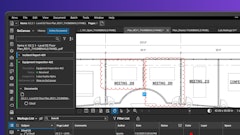
Nearly half of America’s deadliest jobs are in construction, according to insurance analysis firm AdvisorSmith. Responsible construction companies work hard to keep their employees safe from injury and respond immediately and appropriately when injuries occur. Those efforts become more difficult the farther away your projects are from reliable cellular connectivity and medical care.
Wearable satellite asset trackers can keep track of the location of workers in the field. Geofencing technology built into digital mapping applications can automatically trigger alerts if workers enter areas that are known to be hazardous. When accidents occur, the SOS feature in GPS-equipped messengers is the fastest way to call for medical help when there aren’t enough bars on the cell phone for a 911 call.
Rokstad Power is a leading construction company specializing in electric distribution and transmission infrastructure. The company was contracted by two major energy providers to inspect power lines, poles and structures at thousands of locations throughout the year. One line inspector typically carried out 35-50 inspections a day of mechanical and physical parts to determine what kind of maintenance was needed. To meet lone and remote worker safety requirements, Rokstad equipped its staff with GPS messengers. Inspectors used GPS messengers to check in at each location.
The messengers also came in handy in a region prone to extreme heat, air quality problems and hungry wildlife. When one lone worker became dehydrated while hiking into an inspection site, he used the SOS feature, which summoned search and rescue to treat him with fluids and airlift him out of danger.
The most important asset is your people and protecting them in an emergency is essential for construction leaders. Having the right tools to track workers improves communication, boost productivity, and increases revenue by avoiding injury and delays.
Good Timing
Running a big construction job is all about timing. The right people, right equipment and right materials need to reach the jobsites at the right time, stay only as long as they are needed and move on to the next requirement. That takes a tremendous amount of coordination from both project managers in the office and workers on the site. Cell phones are everybody’s go-to device – but when projects take you beyond good cellular coverage, things can fall apart fast.
Satellite messaging devices fill the gap. They are small, easy to use and work just about everywhere on Earth for check-ins, SOS and other messaging. Some units connect via Bluetooth and cell phones, enabling texting everywhere. Best of all, they are affordable, both for the device and the airtime. Where smartphones can ring up big charges, satellite messengers send and receive short bursts of text at attractive rates.
Many construction companies and equipment vendors still rely on phone calls and written logs to track equipment transported to and from jobsites, as well as its actual use. Satellite asset tracking lets companies check the location and status of equipment in near real-time, export data into their applications and accurately track data for billing the time each piece of equipment is used on a project.
For example, a construction company specializing in offshore energy platforms needed a way to improve pen-and-paper tracking of the vessels that kept its jobsites supplied. The company decided to install a small solar-powered asset tracker on each vessel. GPS data from the trackers, displayed on a digital map, triggered a big increase in efficiency of routing vessels. The company also saved time by using geofencing technology – which establishes virtual boundaries – to set alarms if vessels departed from their intended courses.
Running a big construction job is an extreme logistics operation. To get your timing right, you need to know the location of the people, equipment and materials, past and present, so you can plan for the future.
Enhancing Security and Equipment Maintenance
Asset tracking enables construction companies to make sure their equipment goes where it should. But it can also identify equipment going places it shouldn’t be. Geofencing technology can send alerts when there is an unexpected change of position that signals potential theft or misuse.
In addition to communication, satellite messengers report the location of each device, and this data can be automatically displayed on a digital mapping application or fed into your project management or security system. Attaching a small, powerful satellite asset tracker to equipment and materials offers an affordable, long-life option for tracking their location. Solar-powered versions can operate without interruption for up to 10 years. They can report location as frequently as every few minutes or as little as once per day.
For example, when a group of heavy equipment dealerships were being hit by a disciplined criminal team, they learned quickly that those without anti-theft measures in place could only watch the security video footage of the thieves driving off with their equipment, without any way of managing the situation. Once criminals began targeting dealerships that had attached satellite asset trackers to their equipment, geofencing alerts from the trackers alerted police, who caught the criminals after a short chase.
Additionally, the most sophisticated asset trackers have built-in Internet of Things capabilities. Connected by Bluetooth or hard wired to sensors, they can report on everything from engine run-time and temperature to tire pressure and fuel levels. This flow of operating data turns scheduled maintenance into predictive maintenance, based on actual wear-and-tear, which can sharply reduce downtime that throws off schedules and ripples through the project plan.
The complex business of construction is all about time, location and people. Leveraging satellite technology helps construction leaders to manage all three to boost productivity and profitability while meeting their customer needs.


















